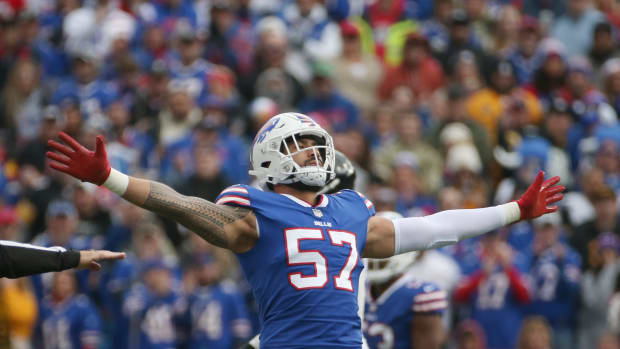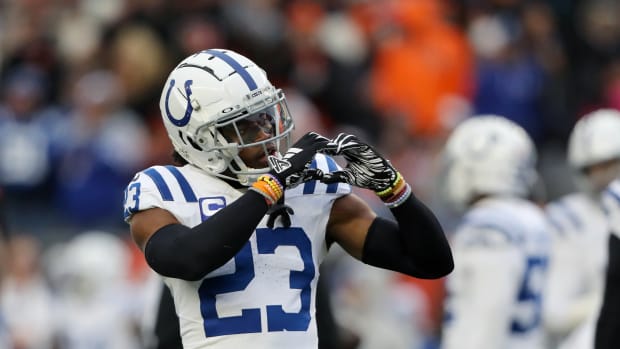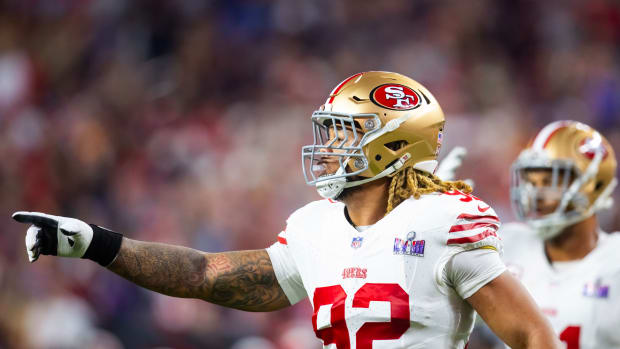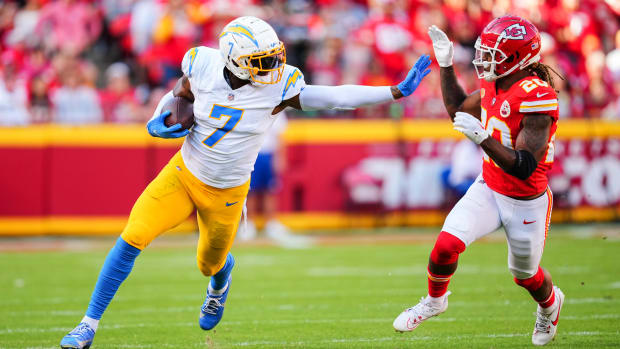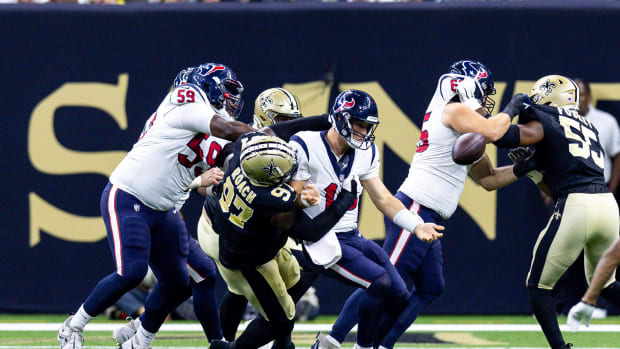Watching tape with New York Giants rookie RB Paul Perkins
Get all of Doug Farrar’s columns as soon as they’re published. Download the new Sports Illustrated app (iOS or Android) and personalize your experience by following your favorite teams and SI writers.
Giants RB Paul Perkins can easily be considered as one of the 2016 NFL draft’s biggest steals before he ever hits the field. Selected in the fifth round, Perkins was the ninth running back taken in his class despite rushing for nearly 3,500 yards and 29 touchdowns, and adding 80 receptions for 739 yards and three more scores, during three seasons at UCLA.
In 2014, the Arizona native led the Pac-12 in rushing with 1,572 yards, and he might have done it again in ’15 had a knee injury not slowed his season. Still, he managed to gain 1,343 yards last year, and caused 85 total missed tackles, which was the most of any running back in college football last year. His 73 missed tackles on running plays ranked second to Alabama’s Derrick Henry—and Perkins did it with 160 fewer carries.
2017 NFL Mock Draft: The QBs set to dominate next spring
Sure, Perkins may have lasted until the fifth round, but he landed on a team in clear need of an every-down back. Last year, Rashad Jennings led the Giants with 963 yards on the ground, and between him and Andre Williams, the Giants ranked 18th in rushing yards, while scoring just five touchdowns on the ground.
“All I can do is go out and perform to the best of my abilities,” Perkins said when I asked him how he feels about landing on a RB-needy team. “I can always improve by asking the coaches what I can improve on, but I won’t know for sure what my role is until I get up there. The conversations we had were very short, just that they were excited to have me. The running back situation is... well, it’s not wide-open, and there are a lot of great running backs up there, but I think I can contribute to the core guys.”
As Marc Ross, the team’s VP of Player Evaluation said after Perkins was picked on the third day, their newest player is “a complete back. He has great vision, one-cut quickness, excellent hands, competitive in the blocking game and outstanding off the field; those were his traits we were attracted by.” Giants coach Ben McAdoo and general manager Jerry Reese echoed the idea that Perkins could be an every-down back sooner than later.
On top of that, football runs in the Perkins family. His uncle Don was a halfback and fullback for the Cowboys from 1961 through ’68, and was named to the Pro Bowl six times. And his father Bruce played for the Buccaneers and Colts in 1990 and ’91.
“Obviously, my dad playing football, you grow up with the game and you always have that strongly rubbing off on you,” Perkins said. “You start to develop your own feelings and emotions for the game with every year you play, and it just gets stronger and stronger. Having him as an influence on my life has increased my love of the game, and to see what it takes to get to the point where I am now, it’s a culmination.”
A few days after Perkins was drafted, and a few days before his first minicamp, we were able to some of his tape. Only Perkins can determine whether the pick is eventually a steal, but he’s a pretty safe bet to succeed.
Play 1: vs. Stanford, second-and-two from UCLA 47-yard-line, 10:10 1Q
Doug Farrar:I wanted to start with the most impressive play I saw. This is a nice display of your field vision, lateral agility and escapability. How important is field vision to what you do? Specifically, the ability to sort of see the gaps opening before they actually do? All running backs talk about reacting to gaps that have already opened, but fewer do it before it actually happens.
Paul Perkins: It’s a little bit of both. When you’re a running back, you have to have that sense of trust in your linemen, and being able to react if something is not there. But definitely, anticipating comes from a lot of film study, and knowing your opponent, and feeling out the flow of the lines. The reaction part—that’s being able to know where and when your cutback is, and being able to see the whole field.
DF:What is this play called? You have a tackle pull here, and you’re obviously focusing on the middle.
PP: This is called TOM, or “tackle on MIKE.” The backside tackle goes full front side with the center to get the MIKE ’backer, and we’re supposed to make our read off of him. If he goes a certain way, we go the opposite way.
DF:So that’s your simple read here on linebacker Blake Martinez? You sort of gauge where he’s going so you know how to turn him out?
PP: Yes, that was more of a reaction. I felt where his body is going with each move and just play off of that. I didn’t see him until the last second, so I made a makeshift move to get him out [of the way], and I knew I could get to the outside, since the inside was clogged up.
DF:After that move, why did you go up and to the left as opposed to breaking that all the way to the right?
PP: I don’t know. I remember seeing a lot of colors there to the right, and I think the strength [of the defense] was over there. I wanted to take it to the weak side.
DF: I imagine this kind of ankle-breaking elusiveness is inherent to a degree, but how can you also work on developing it? Are there exercises to expand that in your play?
PP: I think it’s a little bit of both. I definitely learned from watching some of the old running backs, and just going out to the park and having fun, just trying moves. Like anything, it’s just trial-and-error—some things will work, some things won’t. But I work on putting those things into action on the field.
• BANKS: After strong draft, can AFC South shed its loser reputation?
DF: Who are the running backs you’ve found most inspiring?
PP: You name them, I’ve watched all the great backs: Barry Sanders, Brian Westbrook, Marshall Faulk... just all those guys.
DF: You watch LeSean McCoy at all? Because you remind me a bit of him.
PP: Yeah, I love LeSean McCoy. He was one of my favorite running backs growing up. And even to be mentioned in the same breath with LeSean McCoy is an honor.
Play 2: vs. Stanford, first-and-goal from the Stanford 10-yard-line, 9:27 1Q
DF:In this play, which directly followed the above play, you’re running behind a right tackle pull for a touchdown. I wanted to include this one because it’s more of a power play. On plays like this, patience is very important as you wait for blocks to open. How much was that a point of emphasis throughout your college career, as quick as you can be, to wait for your blocks to develop? Even Adrian Peterson had to learn that when he came into the NFL.
PP: This is “tackle on MIKE” again, just on the other side. We wanted a pretty simple game plan here, to just keep them on their heels and run tempo. And that’s probably the most important part; just being patient and waiting it out to see how your linemen are going to block for you. They’re there to help you out, and you’re not helping them a bit if you outrun the block and stuff like that.
DF:Also, this is a pretty nice power run for a 208-pound player. Do you think you’re underrated in this regard?
PP: Yeah, definitely. I mean, people see me on TV and they think I’m really small. The internet doesn’t do me too much justice! I’m not a tiny guy, so the power aspect of my game is not something that’s too much of a stretch for me.
• BEDARD: Grading the classes of the 2013 NFL draft, three years later
Play 3: vs, Stanford, first-and-10 from UCLA 46-yard-line, 1:30 2Q
DF:Your blocking is underrated, especially in games when your team is behind and needs to constantly throw. Here, you’re getting face up on the outside linebacker Joey Alfieri, and you take him on again closer to the back of the pocket to keep your quarterback clean. How much do you work on blocking, and what did you hear from NFL teams as far as how important it will be to your future success?
PP: I tried to emphasize blocking when I was talking to NFL teams, and I feel that it can be one of my strong suits. But the Giants saw all they needed to see, and I’m glad they believe I can be an every-down back. Teams told me that’s how you make it as a staple in someone’s offense, doing all three things: running, catching and pass-blocking. If you can stay on the field for all three downs, it just makes you more of a prize.
Play 4: vs. USC, fourth-and-one from USC 19-yard-line, 3:32 1Q
DF:Another ridiculous play, this one against USC, where you appear to be out of the play and still keep things going, somehow managing to stay off the ground as you’re faking. What happened on this play?
PP: This is a regular zone play, nothing too spectacular. Everybody in the zone was off to one side, it’s fourth-and-one and we had to get the “get yards.” I’m just trying to make a play.
DF: This is another example of the agility and body control, and how important those things are to what you do.
PP: I feel that it’s one of my biggest attributes, because I’m not 6' 3" and 240 pounds. I’m not the biggest guy, and I’m not going to steamroll somebody, so I have to use all the tools in my toolbox to get by somebody.
• FARRAR: Late-round draft picks who would start this season
Play 5: vs. USC, third-and-four from UCLA 40-yard-line, 14:04 3Q
DF:OK, kind of a blown block here... but not a bad catch! A couple of questions here: First, how should you have blocked this differently? Second, acrobatic plays aside, how much can you help the Giants as a receiver?
PP: [Laughs] Yeah, I should have made the block in the first place, because I knew that once I got to the sideline, my coaches were going to chew me out. So, I had to make something happen out of nothing... it was critical for me, since I messed up already, to do something the second time. I went in with the wrong agenda to block the defender, but thankfully, I made a play out of it. I should have taken my time and closed the gap faster, kept my head up, all basic blocking ideas. Being a receiver was something I really tried to emphasize and work on after practice, so I could be more valuable to my team.





































